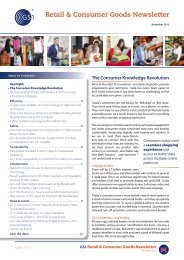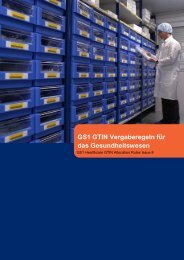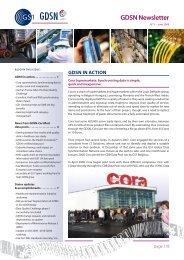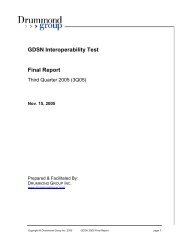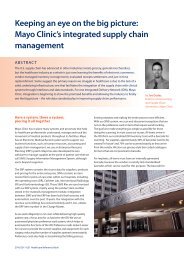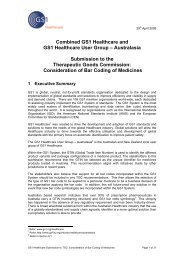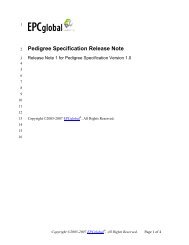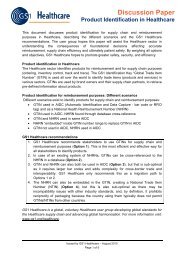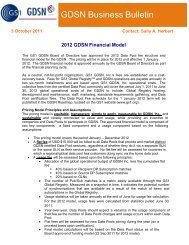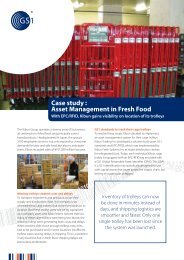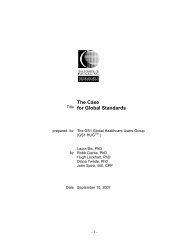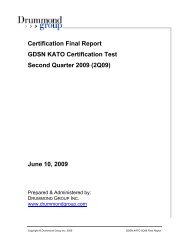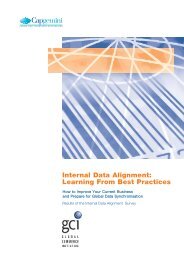Case Study: Using GS1 Standards for Tracking Blood Products
Case Study: Using GS1 Standards for Tracking Blood Products
Case Study: Using GS1 Standards for Tracking Blood Products
Create successful ePaper yourself
Turn your PDF publications into a flip-book with our unique Google optimized e-Paper software.
<strong>Case</strong> <strong>Study</strong>: <strong>Using</strong> <strong>GS1</strong> <strong>Standards</strong> <strong>for</strong><br />
<strong>Tracking</strong> <strong>Blood</strong> <strong>Products</strong><br />
Fergal Mc Groarty, Project Manager,<br />
National Centre <strong>for</strong> Hereditary Coagulation<br />
Disorders, St James Hospital, Ireland
Agenda<br />
Background to the Service<br />
Background to Haemophilia<br />
Issues<br />
Solutions<br />
Outcomes/ROI<br />
Conclusion
Ireland<br />
Population: : 4,156,119<br />
Haemophilia (A) Affects 1 in 5,000 to 1 in<br />
10,000 male live births
St. James’s Hospital
National Centre <strong>for</strong> Hereditary Coagulation<br />
Disorders (NCHCD)<br />
Located at St James’s Hospital, Dublin<br />
Manages patients with inherited and acquired<br />
bleeding disorders<br />
Approximately 2000 patients with<br />
Haemophilia<br />
Approximately 200 patients with severe<br />
haemophilia (require intensive<br />
care/treatment)<br />
Over 75% Patients with severe Factor<br />
deficiency self medicate at home
What is Haemophilia ?<br />
Haemophilia is a bleeding disorder caused by a<br />
deficiency of a clotting factor<br />
Incidence is between 1:5,000 and 1: 10,000 Males<br />
The treatment of haemophilia involves the<br />
replacement of the clotting factor (previously<br />
prepared from pooled blood) using a concentrated<br />
preparation “Clotting Factor Concentrate” (CFC)
The Science bit…!
What triggered the initiative ?<br />
Healthcare<br />
Infection of patients with Hepatitis C and HIV due to contaminated<br />
blood products. Infected products remained in the supply chain after<br />
recall leading to subsequent infection<br />
Lindsay Report 2001<br />
EU <strong>Blood</strong> Directive 2002/98/EC<br />
Industry<br />
<br />
<br />
<br />
<br />
COMBATING COUNTERFEIT DRUGS<br />
A Report of the FDA: February 2004<br />
FDA Counterfeit Drug Task<strong>for</strong>ce Report: 2006 Update<br />
Cali<strong>for</strong>nia: e- Pedigree ruling<br />
Turkey: Regulation on Packaging and Labelling
Business <strong>Case</strong><br />
No Product barcode<br />
Non Availability<br />
Non validated delivery<br />
Incomplete/retrospective<br />
treatment in<strong>for</strong>mation<br />
Incomplete data<br />
Wastage/<br />
ineffective<br />
Medication<br />
Increased Risk
The solutions<br />
Unique <strong>GS1</strong> barcoding<br />
Encrypted<br />
Messaging<br />
validation<br />
Home/Hospital<br />
tracking<br />
Comprehensive<br />
integrated care<br />
Electronic Patient record<br />
Validated cold chain delivery
What does Barcode Technology<br />
offer ?<br />
<br />
<br />
<br />
<br />
<br />
<br />
Identify patients, locations and medications uniquely<br />
Real-time ID and 100% track and trace of all<br />
medication<br />
Studies show the error rate of data entry in a skilled<br />
typist is 1 every 300 keystroke<br />
Error rate in B/C scanning is estimated at 1 in a<br />
million characters<br />
Faster data entry<br />
Scanned data can be transferred easily to any<br />
database
Why <strong>GS1</strong> and Linear Barcodes ?<br />
FDA Ruling<br />
Any linear symbology, including Reduced Space<br />
Symbology (RSS), can be used <strong>for</strong> the bar code<br />
Two-dimensional (2D) bar code symbologies are not<br />
permissible. This includes Data Matrix, which is already<br />
in use in the pharmaceutical industry<br />
RFID is not an acceptable substitute <strong>for</strong> the bar code<br />
EAN.UCC or HIBCC standards may be used, but neither<br />
is required.
Current Barcode (2 Linear)<br />
ID Formats<br />
Product Name<br />
(GTIN)<br />
Manufacturer allocated barcode<br />
Batch Number<br />
Expiry Date<br />
Serial Number<br />
RFID
The solutions<br />
Unique product barcoding<br />
Encrypted<br />
Messaging<br />
validation<br />
Patient<br />
Electronic Patient record<br />
Home/Hospital<br />
tracking<br />
Validated cold chain delivery
National Haemophilia EPR<br />
Working in partnership with a local vendor<br />
(Clintech.ie) to add disease specific<br />
in<strong>for</strong>mation capture<br />
Electronic Chart with up to date in<strong>for</strong>mation<br />
in one place<br />
Accessible in any Haemophilia treatment<br />
centre throughout Ireland
Multi location deployment<br />
National<br />
Haemophilia<br />
Centre<br />
Regional Haemophilia Centers
08/10/2009 Fergal Mc Groarty SJH 18
The solutions<br />
Unique product barcoding<br />
Encrypted<br />
Messaging<br />
validation<br />
Patient<br />
Electronic Patient record<br />
Home/Hospital<br />
tracking<br />
Validated cold chain delivery
Validated Cold Chain Delivery<br />
Over 75% of Patients with severe Factor deficiency<br />
receive product at home<br />
Ensure quality of product using validated scheduled<br />
cold chain delivery (Home/Pharmacy/School)<br />
Licensed by Irish Medicines Board<br />
Home Fridge management (Temperature<br />
monitoring)
How TCP manage the<br />
product<br />
Transport stock to warehouse from IBTS<br />
Pharmacist enters product info onto system (double<br />
checked)<br />
Serialised Bar code is produced, label attached,<br />
scanned to verify<br />
Stock held at validated temperature<br />
Order received from Hospital or Prescription <strong>for</strong> home<br />
delivery, order packed and labelled with SSCC B/C<br />
Patient contacted prior to delivery<br />
Fridge is stocked and temperature data downloaded<br />
All movement is confirmed using hand held scanners
Delivery to the home and “In home” usage<br />
Electronic prescription<br />
Cold Chain receives<br />
home patient orders<br />
with GTIN & delivery<br />
location details<br />
GLNs<br />
Data sent to the EPR and<br />
stock management system<br />
with product usage<br />
in<strong>for</strong>mation<br />
Details of all<br />
movements are sent<br />
to the stock<br />
management system<br />
Patient scans<br />
product.<br />
Verification<br />
received from EPR<br />
Cold Chain Supplier verifies delivery of<br />
product to Patient - recording batch<br />
and expiry details GLN, GTIN, GSRN<br />
Cold Chain Supplier<br />
verifies Order at<br />
dispatch - recording<br />
batch and expiry dates -<br />
GLNs, GTIN
The solutions<br />
Unique product barcoding<br />
Encrypted<br />
Messaging<br />
validation<br />
Patient<br />
Electronic Patient record<br />
Home/Hospital<br />
tracking<br />
Validated cold chain delivery
Solution <strong>for</strong> tracking and tracing<br />
products within the home<br />
Remove paper trail<br />
Reduce risk by providing a check on Patient V<br />
Product suitability<br />
Real time alert product recall<br />
Complete traceability of medication to<br />
infusion<br />
Added value<br />
Clinical In<strong>for</strong>mation gathering and integration with<br />
EPR<br />
Messaging
Phone with integrated<br />
B/C scanner
Patient Scans ID Card<br />
or enters Username<br />
and password
Patient can confirm<br />
details including<br />
treatment of choice
Patient scans the<br />
barcode on the box
A check is per<strong>for</strong>med<br />
against the product of<br />
choice and the expiry<br />
date. An audible and<br />
visible warning will<br />
appear if there is a<br />
problem
The reason <strong>for</strong><br />
treatment can be<br />
entered
Once the patient clicks<br />
“Finish” all in<strong>for</strong>mation<br />
will be transferred to<br />
the EPR and the stock<br />
management system
The solutions<br />
Unique product barcoding<br />
Encrypted<br />
Messaging<br />
validation<br />
Patient<br />
Electronic Patient record<br />
Home/Hospital<br />
tracking<br />
Validated cold chain delivery
Solution <strong>for</strong> tracking and tracing products within the Hospital<br />
Bar coded CFC is<br />
delivered to the Hospital<br />
by TCP<br />
Hospital (GLN)<br />
Stock Fridge (GLN)<br />
Prepare product (GTIN)<br />
Patient receives<br />
CFC<br />
Check Product V Patient and issue<br />
Issue Fridges (GLN)
Main Features of the Hospital<br />
Stock management System<br />
Removes paper trail<br />
Time and date stamp movement<br />
Real-time location of all medication<br />
Medication V Prescription check<br />
Rapid Recall<br />
Reporting suite
Recall Reports
Recall Reports
The solutions<br />
Unique product barcoding<br />
Encrypted<br />
Messaging<br />
validation<br />
Patient<br />
Electronic Patient record<br />
Home/Hospital<br />
tracking<br />
Validated cold chain delivery
Why is validation of Computer<br />
Systems Important?<br />
The FDA believes that the only way to<br />
develop validatable software is within a<br />
”Quality Regulated Environment.”<br />
<br />
SJH choose GAMP, the validation system<br />
of choice <strong>for</strong> European pharmaceutical<br />
industry and is equivalent of<br />
FDA CFR 21 11
Outcomes/ROI<br />
<br />
<br />
EPR<br />
Standardisation of data entry (ICD 10 Coding/procedures etc)<br />
allows better reporting<br />
Access to key clinical in<strong>for</strong>mation available electronically out of<br />
hours via summary screen<br />
<br />
<br />
<br />
Hospital Product tracking system<br />
100% visibility of all stock within the hospital<br />
Detailed reports on stock movement /issued/wastage<br />
Reduce errors by providing an electronic check on product V<br />
prescription be<strong>for</strong>e issue
Outcomes/ROI<br />
Validated Cold Chain delivery System<br />
Since Cold Chain delivery started all products<br />
verifiably delivered between 2 0 -5 0 Celsius<br />
Product wastage reduced from €90,216<br />
to zero in the<br />
immediate year post service implementation<br />
Documentation errors reduced from 12 to zero in the<br />
year post service implementation<br />
€ 5 Million worth of medication stock has been<br />
removed from the supply chain<br />
Mock Recall identified location of all (100%)<br />
Medication within 10 minutes along with quantities of<br />
alternate stock available
What do the patients<br />
think?<br />
Convenience of new service – 100%<br />
satisfaction<br />
Privacy and confidentiality – 99%<br />
satisfaction<br />
Overall service satisfaction rating<br />
89% very satisfied<br />
10% satisfied<br />
1% dissatisfied
Future developments<br />
Continue developing the EPR (additional<br />
functionality)<br />
Roll out the EPR and stock management<br />
system to other Hospitals<br />
Move to Manufacturer allocated<br />
datamatrix B/C and EPC and eventually<br />
RFID?
Datamatrix Barcodes<br />
European Federation of Pharmaceutical Industries (efpia) endorsed the use of datamatrix<br />
barcodes on 30 th May 2007 because it was recognized that RFID is currently “more<br />
expensive and less reliable…”<br />
20 th Jan ’09 - The FDA is calling <strong>for</strong> all drugs to be labelled using a standardised numerical<br />
identifier similar to the one suggested in the delayed Cali<strong>for</strong>nia e-Pedigree guidelines.<br />
Another feature on the guidance is its compatibility with the serialised Global Trade Item<br />
Number (sGTIN) model set up by the international standards organisation <strong>GS1</strong><br />
January 2008 - Pharmaceutical Bar Coding to Improve Patient Safety Options <strong>for</strong> Technical<br />
<strong>Standards</strong> in the Canadian Environment - Roundtable Discussion Paper<br />
“For discussion purposes, ISMP Canada proposes that the guidelines recommend<br />
two-dimensional (Data Matrix) symbology”<br />
The data content and structure of the B/C developed by Baxter/<strong>GS1</strong> and St. James’s Hospital<br />
has become the de facto standard
Regulatory bodies<br />
Turkey: Significant amendments were made in the Regulation on<br />
Packaging and Labelling on February 1 2008. This amendment<br />
introduced new identification and traceability requirements and<br />
stipulates that medicines must have a data matrix type 2-dimensional<br />
barcode. It is worth mentioning that a transitional period is accepted<br />
by the regulators, and licence holders of the medicinal products should<br />
start inserting 2D barcodes in their products at the latest on January 1<br />
2009.<br />
Cali<strong>for</strong>nia: : In January 2011, Cali<strong>for</strong>nia was due to become the first US<br />
state to implement legislation mandating that drug manufacturers,<br />
wholesalers and distributors create electronic pedigrees (e-pedigrees)<br />
to track and trace all prescription drugs distributed within the state.<br />
Now 50% wholesalers must have system in place by 2015 with all<br />
wholesalers and retailers compliant by 2016
EU Catch up?<br />
<br />
<br />
<br />
European Commission consultation document issued on 11th<br />
March 2008<br />
Compared to 2005 seizures of counterfeit medicines at the<br />
boarder of the EU have increased by 380%<br />
The consultation document makes reference to Datamatrix<br />
bar codes<br />
…dealing<br />
with product characteristics and Good Manufacturing<br />
Practices (GMP). Obligatory safety features shall allow <strong>for</strong>;<br />
identification checking, authenticity checking and tracing…
“Heparin recall only partially successful”<br />
(4th Global Forum on Pharmaceutical AntiCounterfeiting 2008)<br />
<br />
<br />
<br />
<br />
<br />
Heparin recall that occurred during the spring of 2008 had only been<br />
partially successful<br />
Recalls had been issued by FDA and, among others, Baxter Healthcare,<br />
several times since contaminated vials of the blood treatment were<br />
found early in the year<br />
According to press reports, upwards of 83 patients have died nationally<br />
as a result of receiving the apparently sub-potent product—making the<br />
recall a high priority throughout the healthcare system<br />
Through May, upwards of 18% of the 500 hospitals in Cali<strong>for</strong>nia still<br />
had unrecalled product in their stockrooms<br />
Some dosages were found that had been returned to intermediate<br />
distributors—and then sent out again !<br />
Source: http://www.pharmaceuticalcommerce.com
Where we are
Conclusion<br />
•Measures need to be implemented to<br />
ensure patient safety<br />
•Barcodes work!<br />
• Simply implementing bar code scanning<br />
can improve patient safety, increase<br />
efficiency and reduce costs<br />
• <strong>GS1</strong> can help with technical issues<br />
(standards) and practical issues<br />
(implementation)<br />
• Medication suppliers are now moving<br />
towards barcoding<br />
• Collaboration with other standards bodies<br />
will simplify processes
Thank You


